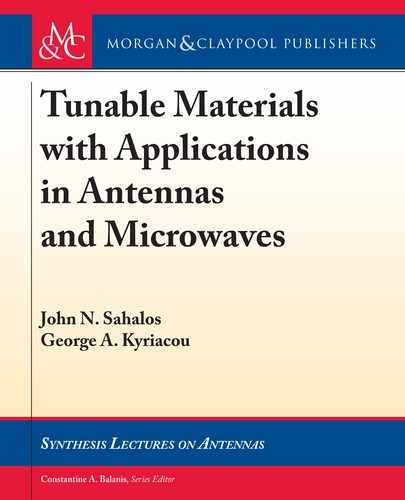
3.10. SPIN WAVES IN AN INFINITE MEDIUM 87
3.10 SPIN WAVES IN AN INFINITE MEDIUM
Let us consider an infinite ferrite medium biased at saturation by a DC magnetic field H
0
in the
z-direction. In addition, assume that exchange interaction is the dominant mechanism exciting
spin waves, that is, neglecting anisotropy. is could be a realistic approximation for some bulk
ferrites, but not for thin films. In turn, the LLG equation (3.23) must be solved with
N
H
ex
given
by (3.19). In addition, recall that for very large sample dimensions, spin waves may be regarded as
plane waves. us, the magnetization vector magnitude could be considered equal to its satu-
ration value perturbed by an infinite sum of spin waves. erefore, the denominator of (3.19)
reads
ˇ
ˇ
N
M
ˇ
ˇ
M
s
. Moreover, a Fourier series expansion can be considered for
N
M .Nr; t/ [16, 23]:
N
M
.
Nr; t
/
D
N
M
s
C
X
K¤0
Nm
K
.
Nr; t
/
D
N
M
s
C
X
K¤0
Nm
K
e
Cj
N
kNr
e
j!t
; (3.27)
where Nm
K
D
m
Kx
; m
Ky
; m
Kz
T
,
N
k Nr D k
x
x C k
y
y C k
z
z,
k
x
D k sin
K
cos '
K
; k
y
D k sin
K
sin '
K
; and k
z
D k cos
K
:
At this point, it can be readily proved that the exchange energy is proportional to k
2
or W
ex
D Dk
2
. For this purpose, consider a single spin wave as a plane wave proportional to
/ e
Cj
N
kNr
e
j!t
, for which it can be easily proved that @=@x D Cj k
x
, @=@y D Cj k
y
, @=@z D
Cjk
z
and, in turn,
N
r D Cj
N
k or .
N
r/
2
D k
2
. Using (3.18), we have W
ex
proportional to Dk
2
.
Following Herring and Kittel [25], and aiming at the resonance frequency of each indi-
vidual spin wave (magnon), we may seek solutions of (3.23) in the form of
N
M D
N
M
s
C Nm
K
e
j
N
kNr
e
j!
K
t
: (3.28)
e corresponding exchange magnetic field of (3.19) becomes
N
H
ex
D C
2A
M
s
k
2
Nm
K
M
s
D Dk
2
Nm
K
M
s
: (3.29)
It is assumed that the magnetization magnitude remains almost constant and equal to its
saturation value
ˇ
ˇ
N
M
ˇ
ˇ
M
s
, and only its direction changes over time. Considering DC bias in
the Oz-direction,
N
H
DC
D H
0
Oz and
N
M
s
D M
s
Oz, the LLG equation (3.23) can be used as a layout
for Cartesian coordinates adopting the usual small signal approximation
ˇ
ˇ
N
H
ac
ˇ
ˇ
ˇ
ˇ
N
H
DC
ˇ
ˇ
, which
yields M
z
D M
s
C m
kz
M
s
and H
z
D H
0
C H
zac
H
0
. For example, we may write:
Nm
K
D
m
Kx
; m
Ky
; 0
and
N
M D
m
Kx
; m
Ky
; M
s
: (3.30)
Instead of solving the LLG equation once again, it is easier to make it equivalent to the
alread-solved demagnetization case. Observing (3.26) in comparison with (3.29), the exchange
field may be included in the LLG equation (3.23) as an equivalent term ŒN
eq
ŒM provided
..................Content has been hidden....................
You can't read the all page of ebook, please click here login for view all page.
